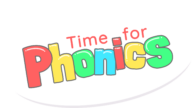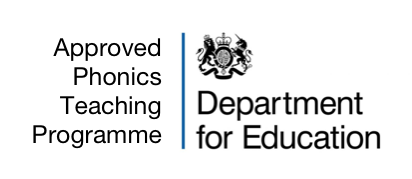**We are delighted to announce that we are a fully DfE validated phonics programme and on the government’s approved list of phonics programme providers.**
So you’ve heard about the DfE phonics validation programme – and now you’re wondering – what is it? On the 1st April 2021, new guidance was released from the DfE (department for education) on the criteria for systematic, synthetic phonics programmes (SSP) which has created some confusion and questions from teachers and schools. In this article, we hope to answer some of the commonly asked questions about the phonics validation programme, and explaining how we can help.
What is a validated phonics scheme?
Phonics has been the buzz word in teaching children to read for quite a while now, and has generally been accepted as the most effective method for children of all abilities to make progress. The DfE believes that high quality phonics teaching improves literacy levels and gives children a solid base upon which to build as they progress through school, as well as helping children to develop the habit of reading widely for both pleasure and for informative purposes.

For a while now, publishers (including us) have been using the Letters and Sounds handbook as a basis for creating phonics schemes with the same order of teaching as is stated in the handbook. This allows schools to dip in and out of Letters and Sounds, and supplement it with phonics games and phonics schemes like ours to best suit their pupils and school community. What the DfE is now seeking to do, is help schools choose from a range of publishers whose offering has been validated by the DfE as meeting a set number of criteria rather than using Letters and Sounds on its own. More about that later… You can find the phonics validation criteria here.
The DfE states:
Validation will indicate that a programme has been self assessed by its publisher and assessed by a small panel with relevant expertise, and that both consider it to meet all of the most recent Department for Education (DfE) criteria for an effective systematic synthetic phonics (SSP) programme.
DfE 2021
What is SSP in phonics?
So you may be asking yourself – what is systematic synthetic phonics? Evidence and research suggests that children learn to read best with a systematic approach to phonics with high quality teaching. But what does it it mean to be “synthetic”? It has nothing to do with polyester style clothes! It simply means the blending or “synthesising” of sounds to make a word. Think about something working in synthesis – it’s when something works together – and that’s exactly what the individual sounds – or phonemes – in words should do. The more phonemes a word has, the more difficult it is to blend the sounds together, which is exactly why a systematic approach must be taken – basically, building up phonetic knowledge in a systematic way that builds on existing knowledge and skills. The DfE says on this:
Phonics is best understood as a body of knowledge and skills about how the alphabetic system works, and how to apply it in reading and spelling, rather than one of a range of optional ‘methods’ or ‘strategies’ for teaching children how to read. A programme should promote the use of phonics as the route to reading unknown words, before any subsequent comprehension strategies are applied. It should not encourage children to guess unknown words from clues such as pictures or context, rather than first applying phonic knowledge and skills.
DfE 2021
So: systematic = using a system, a plan, a consistent approach. Synthetic = breaking words into phonemes and blending them back together.
What do schools need to do about the phonics validation scheme
A complete list of the validated phonics schemes, publishers and providers was made available in January 2023. Now the list has been published, schools will be able to evaluate their current position, what progress children are making in phonics considering pupil outcomes, and decide the most suitable way forward. The final list is of course for guidance only and schools will have to make their own decision on what best to do. If you feel that your current phonics provision is working for your school and pupils, then there may be no reason to change what you’re doing – certainly not in the immediate future. If though, your phonics outcomes are not as good as you’d hoped, you may wish to look for a new phonics scheme in which case it might be wise to wait until the outcome of the validation process.
What is happening to Letters and Sounds?
We were under the impression that the government was going to revisit the widely used and acclaimed Letters and Sounds framework, to bring it into line with changes in the National Curriculum and ensure it is fully resourced. At present, if you follow Letters and Sounds, there are certain aspects that are not congruent with the requirements of the National Curriculum especially in year 1. In addition, phase 6 has been pretty much replaced by the requirements of SPaG in the National Curriculum for year 2 – more graphemes have been added, and some have moved to other year groups making the whole thing quite confusing. With this in mind, it seems reasonable that the framework was revised, to ensure that everything marries up and makes sense. Letters and Sounds taken as a whole is a great document and very useful to experienced teachers. To new teachers though, it can seem overwhelming and difficult to understand. It is a huge document and although contains useful activities and a clear order of teaching, it is not a phonics scheme as it doesn’t have sufficient accompanying resources to ensure full coverage and teach quality phonics. That’s where phonics schemes and phonics websites like ours come in – as teachers and parents seek to supplement what has been provided in Letters and Sounds – or replace it entirely. The DfE themselves said that the 2007 Letters and Sounds handbook has never been a full systematic synthetic phonics programme (SSP), and effective delivery of Letters and Sounds has relied upon schools building themselves a scheme around the handbook. The actual guidance states that:
The 2007 Letters and Sounds handbook, published under the previous government, has never been a full SSP programme.
For a number of years, effective teaching using Letters and Sounds has relied on schools themselves building a programme around the handbook. We recognise, however, that for many schools, especially those who want or need to improve their practice, 2007 Letters and Sounds is not fit for purpose and does not provide the support, guidance, resources or training needed.
We would therefore like to encourage anyone interested in creating full SSP programmes based on 2007 Letters and Sounds to be tested at validation to do so.
The name Letters and Sounds is not currently trademarked. However, we have an interest in ensuring that no one claims or gives the impression that their Letters and Sounds is somehow official or endorsed by the Department for Education. Therefore, anyone wishing to submit their programme for validation may use the name Letters and Sounds, but must preface this with either the name of the organisation, the individual producing their version of the programme or another distinguishing descriptor, for example, John Smith’s Letters and Sounds. This also allows for schools to differentiate between programmes.
DfE 2021
Roll onto March 2021, and the DfE made an announcement that it had decided NOT to continue its involvement with the revision of Letters and Sounds – perhaps due to the demands of the Covid pandemic who knows? They stated that they believed that SSP programmes should be developed by teachers and phonics experts (which we were kind of hoping they would have been working with to revisit L and S?!), and thus, would not be publishing a new phonics programme, nor updating the existing handbook.
Is Time for Phonics a validated phonics scheme?
Yes and in fact we have now been validated on the basis of our phonics scheme and online phonics games. To satisfy the validation criteria, we have now created our own decodable texts to sit alongside our phonics programme, for children to read both in school and at home, and have added on-demand phonics training courses.
Explore our validated synthetic phonics programme today with a no-obligation free trial.



